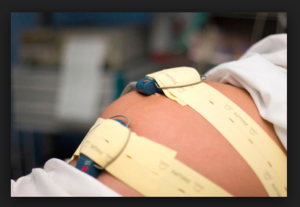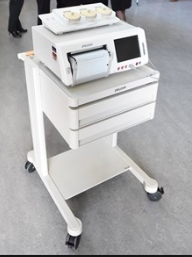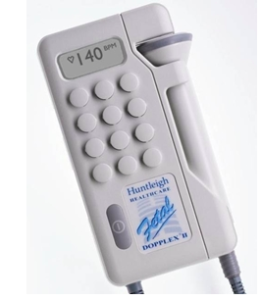Routine EFM, Hospitals economics & the Nancy Reagan “Just Say No” policy of just saying no changing a Standard of Care that is harmful to healthy women with low-risk pregnancies
 The professional journal publications quoted in this series of posts and many other peer-reviewed articles clearly convey the obvious:
The professional journal publications quoted in this series of posts and many other peer-reviewed articles clearly convey the obvious:
The routine use of continuous EFM on low and moderate risk women has never been a science-based practice AND never was able to do what it advertised– eliminate or greatly reduce the rate of CP and other neurological pathologies of the newborn, and while it was NOT doing what it claimed, it was increasing the Cesarean section rate and all the complications — intra-operative, post-operative, delayed and downstream in future pregnancies, as well as the ultimate childbirth-related “complication” — maternal deaths.
Ignoring the Science as a National Cause Celebre: Hospital Corporations, EFM manufacturers, Obstetrical Organizations, State and National Legislatures
Nonetheless, the obstetrical profession and hospitals have masterfully ignored everything they don’t want to hear, decade after decade after dreary decade, as they swept new studies under the rug to join all the earlier studies– something not to be talked about, and certainly not to be acted on!

The R2D2 of EFM!
In spite of the many complications associated with the universal EFM for healthy women with normal pregnancies, and well-established fact that c-EFM is not associated with better outcomes, the practice continues unabated in the 3,400 hospitals in the U.S. that provide obstetrical services.
EFM is now the single most frequently used medical procedure in the US, which is to say that the use a $15,000 electronic monitor system has outstripped every other medical device or procedure in America.
The official estimate is that 85 to 93 % of all childbearing women are hooked up to continuous EFM equipment during their entire labor. [citation L2M Survey 2002 & 2005; Martin et al 2003]
Many health insurance carriers reimburse hospitals up to $400 an hour for intrapartum continuous electronic monitoring. According to doctors and hospitals, this is the cheapest and best way to protect them from multi-million dollar malpractice suit for a damaged baby, and like one’s American Express card, you shouldn’t go anywhere without it!
The April 2011 article quoted in Part 1 acknowledges the lack of a scientific basis for c-EFM, but at the same time, they went on to say some version of:
“ya, but we have to keep using universal EFM because there are too few nurses to use use auscultation”
This means that hospitals in the US have systematically chosen NOT to hire enough L&D nurses to use the ‘alternative’ to EFM — auscultation, a simpler but equally-effective monitoring method that is not accompanied by an increased rate of operative and cesarean deliveries.
 As noted, many hospitals bill health insurance companies and the federal Medicaid program up to $400 an hour for each labor patient who is hooked up to c-EFM. Each hospital is reimbursed many thousands of dollars for an average labor (8-10 hrs = $3200-$4,000), multiplied by 3 to 12 labor patients in the unit at any one time (i.e. generating from $10,000 to $40,000 per shift).
As noted, many hospitals bill health insurance companies and the federal Medicaid program up to $400 an hour for each labor patient who is hooked up to c-EFM. Each hospital is reimbursed many thousands of dollars for an average labor (8-10 hrs = $3200-$4,000), multiplied by 3 to 12 labor patients in the unit at any one time (i.e. generating from $10,000 to $40,000 per shift).
L&D nurses certainly are NOT getting paid $400 an hour (average RN pay in US is btw $28 and $45 an hr). Obviously hospitals in the US find it a whole lot more profitable NOT to hire enough L&D nurses to monitor (i.e. the active verb, not the machine!) the unborn baby using a hand-held Doppler and Auscultation –hands-on listening — protocols.
EFM: Why it’s so good for hospitals as a profit-making business
 Hospitals spend much more on electronic monitoring systems than handheld Dopplers. This is consistent with a decision NOT to hire enough nursing staff to do one-on-one intrapartum care that includes hands-on listening.
Hospitals spend much more on electronic monitoring systems than handheld Dopplers. This is consistent with a decision NOT to hire enough nursing staff to do one-on-one intrapartum care that includes hands-on listening.- blood transfusions
- emergency hysterectomy
- postpartum infections
- rehospitalizations
- all the downstream emergencies:
-
- placenta percreta in future pregnancies that requires a Cesarean hysterectomy
- ICU admission for as long as to 20 days
- maternal death for 7 to 1o out of 100 women.
The routine use of electronic fetal monitoring as the standard of care for healthy women with normal pregnancies is high-tech, high-cost, non-evidence-based care. [EvidenceBasedBirth.com]
Since the first EFM was purchased by the first hospital, the push to expand c-EFM has been ever up, up, upward, irrespective of the science, damn the torpedoes, full speed ahead! There is no doubt that a constant pitch for buying the latest hot new upgrade is being driven by the EFM manufactures, for whom the sale of EFM equipment is so profitable.
Interestingly enough, the economic goals of EFM manufactures fit perfectly with those of hospitals, for whom billing insurance carriers and the federal *Medicaid program hundreds of dollars an hour makes the use of c-EFM into one of their favorite “cash cows”.
As for the health insurance industry, they can afford to reimburse hospitals at this extraordinary rate because it’s just a pass-through for premiums paid by their customers. Anytime the insurance carriers aren’t making as much profit as they want, they can hike premiums up to the moon and back and there is NOTHING we, the public, can do — we either pay or become uninsured. So “cost containment” is not a necessary aspect of health insurance as an unregulated industry.
[**Medicaid pays for half of all births in the US]
For hospitals, this profit-making scenario is the polar opposite of having to spend hundreds an hour to hire enough L&D nurses to provide one-on-one care (i.e. to ‘midwife’ as an active verb) each patient, using IA to monitor the fetus as an eyes-on, hands-on process performed in real time by a real person.
Central Fetal Monitoring: The newest kid on the block half a century later
The introduction of central monitoring allows hospitals to centralization the fetal monitoring function of their L&D units. This new system for transmits the data from individual EFM machines to a central display system; it is just the latest iteration of this fever pitch to replace people with electronics.
 Central fetal monitoring frees up nurses so they no longer have to be personally present in the mother’s labor room. They can skip the patient’s labor room altogether while they monitor several labor patients at one time from the comfort of their chair at the central nurses’ station in the hallway.
Central fetal monitoring frees up nurses so they no longer have to be personally present in the mother’s labor room. They can skip the patient’s labor room altogether while they monitor several labor patients at one time from the comfort of their chair at the central nurses’ station in the hallway.
- The guidelines for labor and birth care of healthy women with uncomplicated pregnancies do not recommend continuous monitoring.
The dilemma that c-EFM poses to obstetricians is rather humorously described in this tongue-in-cheek editorial by Dr. Drosman to his fellow obstetricians.
Why the C-section rate is rising by Dr. Steven Drosman, MD, obstetrician-gynecologist in San Diego, CA; Editorial ~ Medical Economics, Oct 2000 ~
“Probably the biggest C-section motivator, however is fear of a lawsuit. The rational is simple: At worst, you’ll be criticized for performing a C-section but you can be roasted for delaying one!
When a patient is hooked up to a fetal monitor, it initiates an unholy trinity — the anxious patient, the hovering nurse and the paranoid physician. The tension escalates as monitoring devices are added: the fetal scalp electrode, the fetal pulse oximeter, and intrauterine pressure catheter. Add some more Pitocin to the mix, and the action begins.
The labor and delivery nurse watches the monitor and observes decreased variability and persistent late decelerations. The obstetrician is notified, wipes the perspiration from his forehead and pops a handful of antacids.
The patient and her family are informed of the potential crisis, and the can of worms has been opened. More likely than not this “electronically compromised” fetus will be delivered by emergency C-section, with perfect Apgar scores.
Auscultation and dedicated labor and birth attendants who provide one-on-one care as a facet of monitoring fetal well being
The principles and techniques used to monitor fetal well-being via auscultation have already been described in detail. The economic aspect of auscultation was identified above. However, we haven’t discussed the social and psychological aspect of hands-on listening is very different and better for the childbearing woman herself, her family and even for its contribution to the professional satisfaction of the labor and birth attendants.
Auscultation blends the classic and the radical. Prior to technological obstetrics, labor and birth attendants provided one-on-one care that included support, encouragement and continuity as the norm. This is also the most appropriate model for using auscultation, which allows the unborn baby to be frequently monitored while its laboring mother-to-be provided social, emotional and physical support.
Of course, the use of auscultation in our technologically-centric obstetrical system is about as radical as one can get. For childbearing families and professional labor and birth attendants, this is a marriage made in heaven.
However hospitals, who experience the universal use of c-EFM as providing a large stable revenue stream via billing insurance companies and MediCaid, they see auscultation and the one-one-care care as a marriage made in hell.
Next in MAYDAY Series: 4-C ~ Development of automated EFM and displacement of Auscultation
